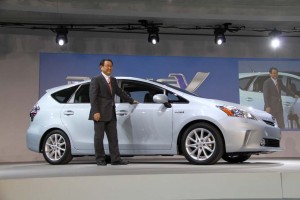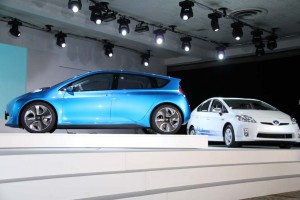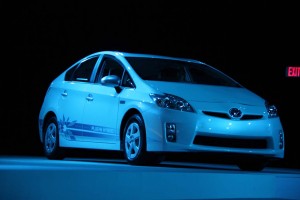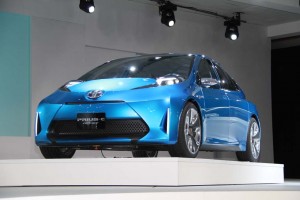If you ask where the Toyota Prius is at the 2011 Detroit Auto Show don’t be surprised if the response is, “Which one?”
Already the world’s best-selling hybrid-electric vehicle, Toyota plans to turn Prius into an even bigger presence, it confirmed Monday, by adding a variety of new models sharing the Toyota badge. That will soon include a roomy wagon, an affordable compact and a plug-in Prius, with still more models under considerations, Toyota officials said.
“Consumers convinced us to expand Prius into an all-new family,” said Bob Carter, Toyota brand boss, during a Cobo Hall news conference.
 For Toyota, at least, the Prius nameplate has become almost interchangeable with hybrid – though not entirely. The maker plans to launch 11 new gas-electric models worldwide over the next 23 months, including seven entirely new offerings – only some of those destined to wear a Prius badge, stressed Carter, noting, “Each family member will be an all-new model.”
For Toyota, at least, the Prius nameplate has become almost interchangeable with hybrid – though not entirely. The maker plans to launch 11 new gas-electric models worldwide over the next 23 months, including seven entirely new offerings – only some of those destined to wear a Prius badge, stressed Carter, noting, “Each family member will be an all-new model.”
During the event Carter and Toyota Motor Co. CEO Akio Toyoda rolled out three models that fit the guidelines. That includes a long-discussed plug-in version of the current Prius. The lithium-ion-powered vehicle will be able to get 13 miles solely on battery power – compared to barely a mile for the current Prius. And it will be able to do so at speeds up to 60 mph compared with 25 for the standard hybrid.
(By comparison, however, the Chevrolet Volt plug-in, which Monday was named North American Car of the Year, can get 25 to 50 miles per charge before switching to gasoline power, and operate at speeds up to around 90 mph.) Charging times will be 3 hours using a 110-volt pack and 1.5 hours on a Level II, 220-volt charger.
Due to market in 2012, the Prius plug-in will initially be offered in 14 states along the East and West Coasts, eventually rolling out across the country.
The plug-in will launch shortly after the completely new Prius V, a tall wagon that, while roughly sharing the footprint of the current Prius hybrid will offer about 60% more cargo capacity.
“Especially designed for young people,” according to Carter, it will get an anticipated 42 mpg City and 38 Highway.
The Prius V will be the first Toyota to use the new EnTune infotainment system, which won best-of-show during last week’s Consumer Electronics Show, in Las Vegas.
Arriving in dealerships late summer, the first addition to the Prius line-up will boast seven airbags and other features designed to minimize concerns generated by Toyota’s recent safety recalls.
After unveiling the plug-in Prius and the Prius V, Toyota officials offered a glimpse just slightly further into the future in the form of the Prius C Concept. The futuristic prototype will serve as “the inspiration for our next family member, which we plan to launch early next year,” announced Carter.
This “value-oriented” hybrid apparently is aimed to be the lowest-priced hybrid on the market, if Carter’s hints are any indication.
The Prius C, he said, is “a dynamic vehicle with an urban feel” that is aimed at young singles. Along with a rock-bottom price – for a hybrid, anyway – anticipate mileage in excess of 50 mpg in the City.
Notably absent from the fast-growing Toyota Prius family is anything resembling a pure battery-electric vehicle. And there are “none currently in the plans,” acknowledged Toyota’s top U.S. executive Jim Lentz, though the maker does plan to produce a battery-based version of its RAV4 hybrid and another pure battery-electric, it has announced.
“We think the traditional hybrid will remain our core vehicle into the future,” he asserted, adding that BEVs don’t fit the image or the expectations of what can be called a Prius.
Could still more models be added to the happy hybrid family? Possibly, though Toyota isn’t confirming anything for now. Even so, said Lentz, “I’m convinced that this decade, the entire Prius family will be the largest-selling passenger car nameplate in the market,” surpassing the current sales leader, Toyota’s own Camry.




